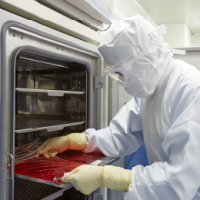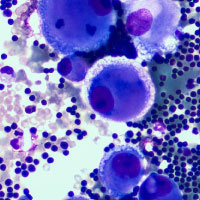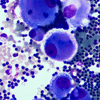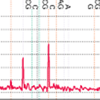Amplifying our understanding of breast cancer metastases
Pernicious in pink: the cost of breast cancer
 Breast cancer is one of the most common types of cancer among US women, represents a major cause of death, and carries the highest treatment cost of any cancer (Smith et al. 2018; Costs of Care 2019; American Cancer Society 2019). Although several treatment options exist, some subtypes are still difficult to treat (Patel et al. 2018). One example is triple-negative breast cancer (TNBC), a subtype characterized by high metastatic effect (~35% of patients will have metastases within 5 years of diagnosis) and extreme intratumoral heterogeneity.
Breast cancer is one of the most common types of cancer among US women, represents a major cause of death, and carries the highest treatment cost of any cancer (Smith et al. 2018; Costs of Care 2019; American Cancer Society 2019). Although several treatment options exist, some subtypes are still difficult to treat (Patel et al. 2018). One example is triple-negative breast cancer (TNBC), a subtype characterized by high metastatic effect (~35% of patients will have metastases within 5 years of diagnosis) and extreme intratumoral heterogeneity.
In a recent article, Echeverria et al. investigated the genomic and exomic profiles of these heterogeneous tumoral cell populations (Echeverria et al. 2018). Using a cellular barcoding strategy powered by our Titanium Taq DNA polymerase, these researchers were able to link these profiles to metastatic features and identify genetic patterns associated with metastatic effect.
On the case: tracking metastatic lineages
To trace cell lineage, researchers generated a lentiviral library containing >50 million unique barcodes and used it to infect patient-derived TNBC cells. Coupled with a low multiplicity of infection, this strategy helped ensure the specificity of barcodes to individual cells and allowed for the tracking of individual cells. These barcoded cells were then xenografted onto the mammary fat pad (MFP) of mice and allowed to grow for ~9 months, resulting in a primary MFP tumor with metastases in brain, lung, and liver. Tumors were resected from MFP and metastases once at 12 weeks and again at 33–37 weeks.
gDNA was extracted from tumor resections and then subjected to PCR amplification. Given the small starting sample material and need for sensitive, specific, and robust amplification, researchers used Titanium Taq DNA polymerase to amplify gDNA in two rounds of PCR. The first-round PCR amplified the cellular barcode, while the second-round PCR introduced the required indexes for Illumina next-generation sequencing.
Following sequencing, researchers discovered that, while primary MFP tumors contained an average of ~500 dominant barcodes, metastases contained averages of only 36 (brain), 18 (liver), and 8 (lung) dominant barcodes. Strikingly, in each mouse, <10 barcodes made up the overwhelming majority of barcoded cells in each metastatic lesion. While the initial library complexity prevents barcode comparison between mice, within each mouse the metastatic-dominant barcodes were 1) identical across all metastases and 2) consisted of barcodes present in the MFP tumor. These observations suggest a small proportion of tumor cells possess a selective advantage in seeding and propagating metastases, with the ability to do so in an organ-independent fashion.
Bulletproof amplification with Titanium Taq
Every detail of your experimental setup matters. Even seemingly minor decisions such as which polymerase to use can have a big impact on optimization, experimental outcomes, and quality of data. In this study, the authors were challenged with examining gDNA from single-cell tumor samples, which are notorious for low levels of the target DNA. Obtaining quality data necessitated a polymerase with specific, sensitive, and high-yield amplification, and our Titanium Taq rose to the challenge. Learn more about how Titanium Taq and our other polymerase solutions can solve your PCR challenges.
References
American Cancer Society. Breast Cancer Treatment | Treatment Options for Breast Cancer. at <https://www.cancer.org/cancer/breast-cancer/treatment.html>
Ryan, S. Costs of Care | The Costs of Breast Cancer in the U.S. - Costs of Care. at <https://costsofcare.org/the-costs-of-breast-cancer-in-the-u-s/>
Echeverria, G. V. et al. High-resolution clonal mapping of multi-organ metastasis in triple negative breast cancer. Nat. Commun. 9, 5079 (2018).
Patel, N. et al. Integrated genomics and functional validation identifies malignant cell specific dependencies in triple negative breast cancer. Nat. Commun. 9, 1044 (2018).
Smith, R. A. et al. Cancer screening in the United States, 2018: A review of current American Cancer Society guidelines and current issues in cancer screening. CA. Cancer J. Clin. 68, 297–316 (2018).
PCR enzyme brochure
Download our PCR product brochure and find the best polymerase for your assay.
Titanium Taq for high-throughput genotyping
Titanium Taq DNA Polymerase is unrivaled for multiplex PCR in high-throughput genotyping applications.
Titanium Taq citations
Examples of peer-reviewed studies that used Titanium Taq for multiplex PCR, single-copy PCR, and telomere detection.
Titanium Taq EcoDry premix
A lyophilized (dried-down) PCR master mix for high-yield and convenient PCR; simply add PCR-grade water along with your primers and template.
Titanium Taq DNA Polymerase
Titanium Taq DNA Polymerase delivers highly sensitive and extremely robust performance in all PCR amplification applications.

Clinical development of gene therapies targeting cancer
Takara Bio Inc. (TBI), the parent company in the Takara Bio Group of companies, is leading the way in the fight against cancer by developing technologies and conducting clinical trials for the treatment of acute lymphocytic leukemia, synovial sarcoma, malignant melanoma, and pancreatic cancer.
Explore TBI projects
CAR T-cell therapy: the latest weapon in the fight against cancer
Read our blog post examining how CAR T-cell therapies for blood cancers show promise for a safer, targeted, and more effective cancer treatment.
Learn moreTakara Bio USA, Inc.
United States/Canada: +1.800.662.2566 • Asia Pacific: +1.650.919.7300 • Europe: +33.(0)1.3904.6880 • Japan: +81.(0)77.565.6999
FOR RESEARCH USE ONLY. NOT FOR USE IN DIAGNOSTIC PROCEDURES. © 2025 Takara Bio Inc. All Rights Reserved. All trademarks are the property of Takara Bio Inc. or its affiliate(s) in the U.S. and/or other countries or their respective owners. Certain trademarks may not be registered in all jurisdictions. Additional product, intellectual property, and restricted use information is available at takarabio.com.










